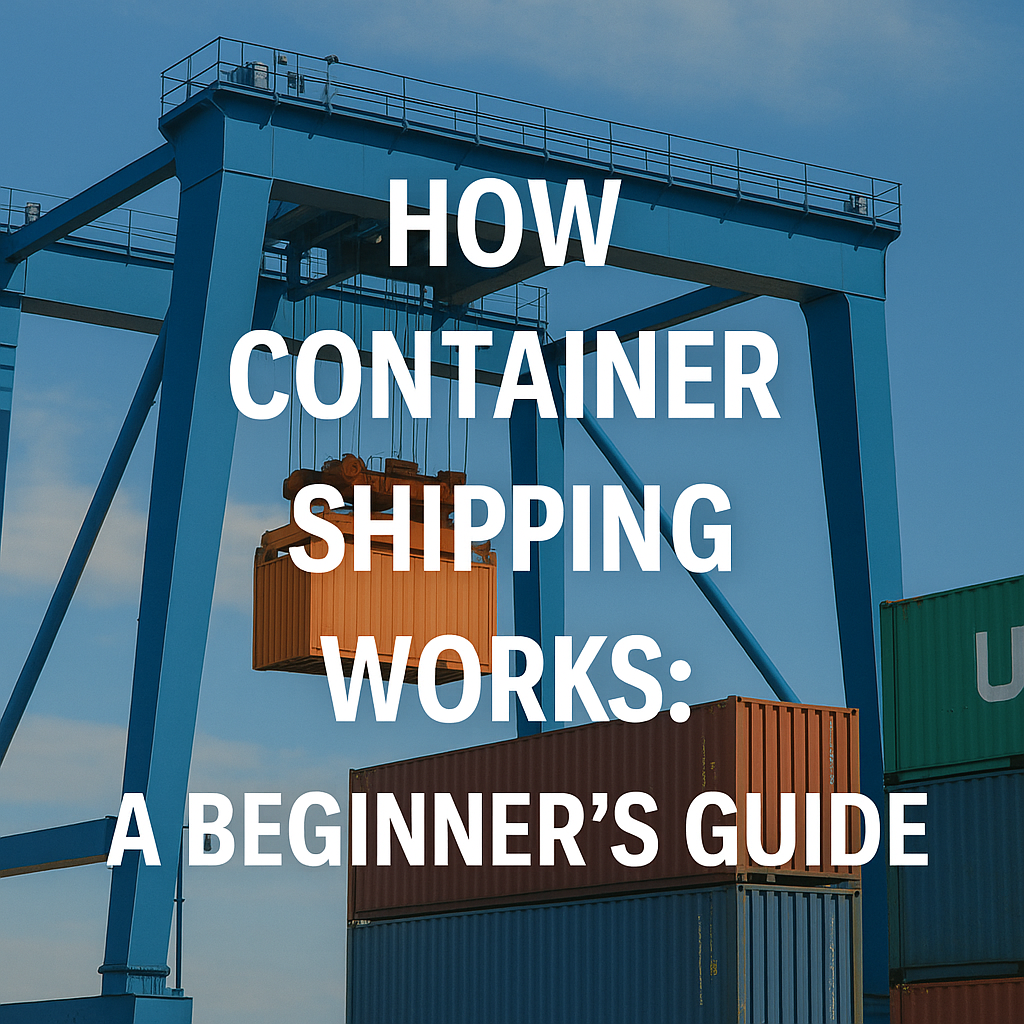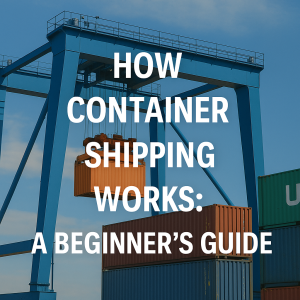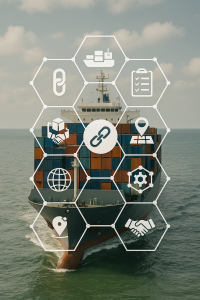Curious about how container shipping works? Discover the key steps, technologies, and challenges of global freight transport in this beginner-friendly guide.”
If you’ve ever ordered a product online—from a phone case to a couch—there’s a good chance it crossed an ocean in a container ship. In fact, over 90% of global trade is carried by sea, and container shipping is the backbone of that system.
But how does it all work? How do those metal boxes move from a factory in China to a retail shelf in Canada, the U.S., or Ghana?
Whether you’re a maritime student, logistics enthusiast, or curious traveler, this beginner’s guide will walk you through the key processes, players, and technologies that keep global container shipping running in 2025.
Why Container Shipping Matters in Modern Maritime Operations
The modern world runs on container shipping. It’s the invisible engine behind globalization.
According to UNCTAD’s 2024 Review of Maritime Transport, global containerized trade surpassed 180 million TEUs (Twenty-foot Equivalent Units) in 2023, supporting everything from electronics and textiles to food and pharmaceuticals.
“Containerization has revolutionized cargo transport, reducing shipping costs by over 70% since the 1960s,” — ICS, 2023 Maritime Trade Outlook
The system’s efficiency, scale, and standardization have made it possible to:
-
Move goods faster and cheaper than by air or land
-
Create complex supply chains across continents
-
Support economic growth in both developed and emerging nations
–
Key Players in the Container Shipping Process
Understanding who does what is crucial. Here’s a simplified breakdown of the main participants in the container shipping chain:
1. Shippers and Exporters
These are manufacturers or businesses who need to send goods overseas. They package the products, often in containers, and arrange shipping.
2. Freight Forwarders
Act as intermediaries—booking space on ships, handling paperwork, and coordinating inland transport. Think of them as logistics brokers.
3. Ocean Carriers
Shipping companies like Maersk, MSC, CMA CGM, and ONE own and operate container ships. They move containers from port to port.
4. Port Terminals
Facilities equipped with cranes, storage yards, and customs services. Notable terminals include:
-
Port of Rotterdam
-
Port of Singapore
-
Port of Los Angeles
5. Customs Authorities
Ensure cargo meets legal, safety, and tax regulations. In Canada, this would be the CBSA; in the U.S., CBP; and globally, systems are harmonized under WCO guidelines.
6. Consignees and Importers
The end recipients of goods. These can be wholesalers, retailers, or even individuals.
–
Step-by-Step: How Container Shipping Actually Works
Step 1 – Booking and Documentation
-
A shipper hires a freight forwarder to arrange cargo movement.
-
Key documents include: Bill of Lading, Packing List, Commercial Invoice, Certificate of Origin.
Step 2 – Inland Transport to the Port
Containers are moved by truck or rail from the warehouse to the departure port. In countries like the U.S. or Canada, intermodal transport is common.
Step 3 – Port Handling and Loading
At the terminal:
-
Containers are inspected (sometimes x-rayed).
-
Loaded using ship-to-shore gantry cranes.
-
Tracked using terminal operating systems (TOS) like Navis N4.
Step 4 – Ocean Voyage
-
Carriers use mega-ships like the MSC Gülsün (over 23,000 TEU capacity).
-
Vessels follow fixed schedules, known as liner services, along routes like:
-
Asia–Europe
-
Trans-Pacific
-
Asia–Africa
-
Step 5 – Destination Port Operations
-
Unloading using cranes.
-
Transshipment may occur if the port is not the final destination.
Step 6 – Customs Clearance
Cargo must be cleared before entering the local market. Smart ports now use AI-powered risk screening to speed up this process.
Step 7 – Final Delivery
The container is delivered to its final location—warehouse, store, or end user.
Key Technologies and Developments Driving Change
1. Smart Containers
Equipped with IoT sensors, these containers provide real-time data on:
-
Location
-
Temperature (for perishables)
-
Tampering or delays
Brands like Maersk Spot and Hapag-Lloyd LIVE are leading this transformation.
2. Port Automation
Ports like Rotterdam, Busan, and Singapore now feature:
-
Automated guided vehicles (AGVs)
-
Remote-controlled cranes
-
AI-based yard planning
According to the British Ports Association, automation improves throughput by 30% and reduces accidents.
3. Blockchain in Shipping
Projects like TradeLens (Maersk and IBM) enable secure, tamper-proof documentation and faster customs processing.
4. Sustainable Shipping
Driven by IMO 2023 carbon intensity regulations, carriers are:
-
Investing in LNG-fueled ships
-
Trialing wind-assisted propulsion
-
Using slow steaming techniques to reduce emissions
–
Real-World Applications: From China to Canada
Case Study: A Container Journey from Shenzhen to Toronto
-
Shenzhen Factory: LED TVs are loaded into a 40-ft container.
-
Trucked to Yantian Port: Cargo is cleared by Chinese customs.
-
Loaded onto CMA CGM vessel: Heads toward Port of Vancouver via Trans-Pacific route.
-
Vancouver Port: Customs inspection and rail transfer.
-
Rail to Toronto: Via CPKC rail, delivered to importer in 21 days.
“The efficiency is remarkable—22,000 km of transport, five modes of handling, under one unified tracking system,” — Freight Forwarder, 2024
–
Challenges and Solutions in Container Shipping
1. Port Congestion
Global disruptions (e.g., COVID-19, Suez blockage) have shown how quickly ports can become bottlenecks. Solution: Digital queuing systems and better container dwell time management.
2. Container Imbalance
Some regions import more than they export, leading to empty container repositioning. Digital matching platforms like xChange are tackling this.
3. Environmental Concerns
Shipping contributes ~3% of global GHG emissions. Solutions include green corridors, biofuels, and stricter IMO EEXI/CII enforcement.
–
Future Outlook for Container Shipping
By 2030, expect to see:
-
Fully autonomous container ships (e.g., Yara Birkeland-type models)
-
Widespread adoption of digital bills of lading (eBL)
-
Near-shoring and reshoring trends, altering trade routes
-
Greater emphasis on resilience and agility, not just efficiency
The industry is evolving, but the core principle remains: moving goods reliably across oceans.
–
FAQ: Container Shipping Basics
1. How long does container shipping take?
It depends on the route. Asia to North America averages 15–25 days. Add extra time for customs and inland transport.
2. What’s a TEU?
A Twenty-foot Equivalent Unit is the standard measurement for container volume. A 40-ft container equals 2 TEUs.
3. Is container shipping safe for fragile goods?
Yes, with proper packaging and handling. Reefer containers (refrigerated) are used for perishables.
4. Do ships follow fixed routes?
Yes, most container vessels operate on liner schedules with fixed weekly departures.
5. What’s the difference between FCL and LCL?
-
FCL (Full Container Load): One shipper fills the entire container.
-
LCL (Less than Container Load): Multiple shipments share one container.
6. Can individuals use container shipping?
Yes—especially for moving household goods. Freight forwarders help arrange the process.
7. What happens if my cargo is delayed?
Carriers offer demurrage and detention terms, and delays may trigger insurance claims under marine cargo insurance policies.
Conclusion: Global Trade, One Container at a Time
Container shipping is the invisible highway of our global economy. From the shoes you wear to the smartphone you use, chances are it made part of its journey in a steel box on a massive ship.
By understanding how this system works—from booking and loading to customs and final delivery—you not only appreciate the complexity behind modern trade but can also make better-informed decisions, whether you’re a student, shipper, or maritime professional.
Key takeaway: Container shipping is efficient, global, and rapidly evolving. Stay informed, stay curious, and you’ll always be a step ahead in understanding how the world moves.
References
-
UNCTAD. (2024). Review of Maritime Transport. https://unctad.org
-
IMO. (2023). Regulations on Carbon Intensity Index (CII). https://www.imo.org
-
Lloyd’s List Intelligence. (2024). Global Port Rankings & Trends. https://lloydslist.maritimeintelligence.informa.com
-
Maersk. (2024). Container Tracking Systems Overview. https://www.maersk.com
-
International Chamber of Shipping (ICS). (2023). Maritime Trade Outlook. https://www.ics-shipping.org
-
Port of Rotterdam Authority. (2024). Automation and Sustainability Reports. https://www.portofrotterdam.com
-
BIMCO. (2024). Freight Market Analysis. https://www.bimco.org
-
World Bank. (2023). Logistics Performance Index. https://www.worldbank.org




Hey! This is kind of off topic but I need some guidance from an established blog.
Is it very hard to set up your own blog? I’m not vety techincal but
I can figure things out pretty quick. I’m thinking about creating my own but I’m not sure where to start.
Do you have any ideas or suggestions? Cheers